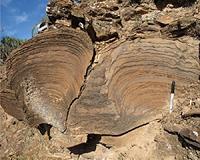| . |  |
. |
Durham, UK (SPX) Aug 24, 2010 A massive reduction in grasslands and the spread of forests may have been the primary cause of the decline of mammals such as the woolly mammoth, woolly rhino and cave lion, according to Durham University scientists. The findings of the new study challenge the theory that human beings were the primary cause of the extinction of mammals through hunting, competition for land and increased pressure on habitats. The research is part of the most comprehensive study to date of Northern Hemisphere climate and vegetation during and after the height of the last Ice Age, 21,000 years ago. It shows that, over a huge part of the Earth's surface, there was a massive decline in the productivity and extent of grasslands due to climatic warming and the spread of forests. These habitat changes made grazing much more difficult for large mammals and dramatically reduced the amount of food available for them. The changes in grassland quality and availability coincided with increases in the distribution and abundance of modern man, Homo sapiens, ensuring a time of wide-scale upheaval for herbivorous mammals and other mammals that preyed on them. The decrease in productivity and extent of grassland is likely to have been the major contributor to the extinction of many large mammals across most of northern Eurasia and north-western North America by about 11,400 years ago, the onset of the present warm interglacial period. Although some species held on for several thousand years longer in very limited localities, their fate had effectively been sealed. Professor Brian Huntley, from the School of Biological and Biomedical Sciences at Durham University, said: "Woolly mammoths retreated to northern Siberia 14,000 years ago whereas they had roamed and munched their way across many parts of Europe, including the UK, for most of the previous 100,000 years or more. "The change from productive grasslands across large areas of northern Eurasia, Alaska and Yukon to less productive tundra-like habitats had a huge effect on many species, particularly on the large herbivores like the woolly rhinoceros and woolly mammoth. Mammoths and other mega-mammals found it increasingly difficult to find food. "We believe that the loss of food supplies from productive grasslands was the major contributing factor to the extinction of these mega-mammals." The Durham University-led team, including scientists from The Natural History Museum, London; Lund University, Sweden, and Bristol University, publish their results in the prestigious scientific journal, Quaternary Science Reviews. Their study, funded by the Natural Environment Research Council (NERC), looked at ancient pollen records and they also simulated developments in vegetation and habitat linked to climatic change, during and following the last glacial stage. The team looked at results for a vast geographic area including Eurasia (Europe and northern Asia) and the area of the Bering land bridge that connected Alaska (USA) and the Yukon (Canada) to Siberia, Russia at the height of the last glacial. They found the post-glacial warming of the planet coupled with an associated change to a moister climate and with increased levels of carbon dioxide in the atmosphere, resulted in the proliferation of trees and the subsequent decline in grasslands - the staple diet and fodder of large herbivores. The decline in herbivores had knock-on effects for other parts of the food chain. Different theories exist for the cause of the extinction of mega-species like the mammoth. The rise of modern man, Homo sapiens, is cited by some as a potential cause. Environmental changes have also been considered as a potential factor in the extinction of mega-herbivores such as the mammoth. This new evidence of massive habitat change linked to climatic change is, according to experts, a parable for modern times. Prof Huntley said: "This was a time of major environmental change and losses of habitat that may have led to the extinction of herbivores and other mega-species that roamed many parts of the planet. "This is a model for what may happen as a result of rapid climate change over the next century linked to human activity. It is food for thought in these times of global warming and human-induced habitat change. There may well be a lesson to learn." The big species today, such as elephants and rhinoceros, are the ones that are most likely to be the first affected by climate change and habitat pressure.
Five species formerly present in Europe, northern Asia, Alaska and Yukon that became globally extinct as grassland diminished: + Woolly mammoth + Cave lion + Giant deer + Woolly rhino + Cave bear
Five species that survived as grassland diminished: + Brown bear + Elk (moose) + Reindeer + Saiga antelope + Musk ox
Share This Article With Planet Earth
Related Links Durham University Darwin Today At TerraDaily.com
 Animals Appeared Even Earlier
Animals Appeared Even EarlierArlington VA (SPX) Aug 24, 2010 Scientists may have discovered in Australia the oldest fossils of animal bodies. These findings push back the clock on the scientific world's thinking regarding when animal life appeared on Earth. The results suggest that primitive sponge-like creatures lived in ocean reefs about 650 million years ago. The shelly fossils, found beneath a 635 million-year-old glacial deposit in South Austra ... read more |
|
| The content herein, unless otherwise known to be public domain, are Copyright 1995-2010 - SpaceDaily. AFP and UPI Wire Stories are copyright Agence France-Presse and United Press International. ESA Portal Reports are copyright European Space Agency. All NASA sourced material is public domain. Additional copyrights may apply in whole or part to other bona fide parties. Advertising does not imply endorsement,agreement or approval of any opinions, statements or information provided by SpaceDaily on any Web page published or hosted by SpaceDaily. Privacy Statement |